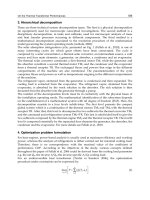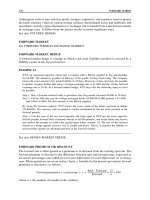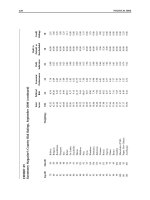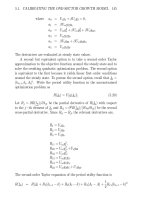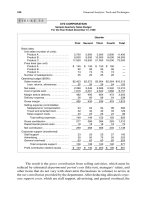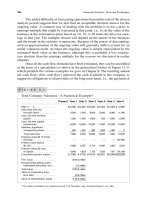- Trang chủ >>
- Khoa Học Tự Nhiên >>
- Vật lý
OBJECT-ORIENTED ANALYSIS AND DESIGN CONCEPTS OF SPACE AND TIME Phần 5 doc
Bạn đang xem bản rút gọn của tài liệu. Xem và tải ngay bản đầy đủ của tài liệu tại đây (116.38 KB, 14 trang )
OBJECT-ORIENTED ANALYSIS AND DESIGN
43
3.5 VERSION MANAGEMENT APPROACHES
According to Loomis, ‘Versioning is the tracking of the evolution of an object’s state
through time’ (1992, p. 40). Deciding on a version management approach for a spatio-
temporal data model involves finding a way to integrate the approach and the model.
The version management approach requires being consistent with object-oriented
concepts. Table 3.2 describes the main approaches developed for managing versions
within databases and their application in a GIS context.
Currently, two main strategies are used to represent multiple versions of an object
within an object-oriented database. The first strategy consists of version numbers or
time stamps being associated with every attribute or relationship of an object. These
attributes or relationships may then be chained, giving them a historical order. The
result is a single object and identity (OID) with the versions actually associated with
the attributes. This approach could have advantages only in models in which the objects
have several attributes as well as changes occurring to only a few attributes.
The second strategy is to track versions at the level of objects rather than attributes.
Chaining the old object and any older versions to the new version creates a new
version of an object. As a result, a different identifier (OID) is associated with the new
version, hence each version has its unique identifier within the version configuration.
So far no performance studies have been undertaken on these alternatives. Nevertheless,
both alternatives involve the design of operations for handling the dynamic behaviour
of versions within the object-oriented data model. Ordering versions within a data
model is an important aspect in object orientation. Despite the development of storage
devices, such as optical disks, offering new capabilities for storing large amounts of
data, a significant waste of storage space will still be minimised by ordering versions
compactly. The proper choice of a method for ordering temporal data relies on
producing the best performance for a given application.
3.6 CONCLUSIONS
Object orientation is an important related interdisciplinary research domain that can
uphold the task of incorporating time in GIS. The fundamental concepts encountered
in the object-oriented approach offer useful improvements in functionality, clarity of
data modelling and the potential for simplifying future application developments in
GIS: ‘A common difficulty in…[GIS] application areas is the gulf between the richness
of the knowledge structures in the application domains and the relative simplicity of
the data model in which these structures can be expressed and manipulated. Object-
oriented models have the facilities to express more readily the knowledge structure of
the original application’ (Worboys, Hearnshaw and Maguire, 1990, p. 370). Therefore,
the object-oriented paradigm is viewed as an approach capable of handling the spatio-
temporal semantics of Time Geography. The Time Geography framework will be
embedded within our spatio-temporal model through the modelling capabilities
provided by object orientation. Our spatio-temporal data model is described in the
next chapter.
45
CHAPTER FOUR
The spatio-temporal
data model
The term representation means an arrangement or organization of data defined within
an explicit set of primitive elements [entities], attributes [properties], and relationships.
Such an arrangement serves to preserve the information inherent in the data for
subsequent use in problem-solving or analytical evaluation. A representation can be
purely conceptual, but any representation must be expressed in formalized
mathematical or programming terms for computer implementation. A formalized
representation intended for computer implementation is known as a data model.
D.Peuquet
Developing our spatio-temporal data model (STDM) based on Time Geography and
object orientation has certain implications that must be taken into consideration
independently of the knowledge domain we are hoping to represent:
< The spatio-temporal data model emphasises the interaction between events and
states rather than a linear connection among them over a space-time path.
< The space-time path offers an appropriate semantic abstraction for handling only
valid time in a spatio-temporal data model.
< The space-time path requires a different version management approach for
incorporating change into a database. Most of the approaches extend the relational
model by creating new versions of tables, tuples or attributes to reflect changes
occurring over time. A new version management approach is necessary to deal
with changes that are represented by the synchronisation of events and states.
< Object-oriented analysis and design is required for the development and
implementation of the spatio-temporal data model within a GIS.
The strengths of the STDM and its implementation lie in the well-defined concepts
and representations developed in Time Geography and object-oriented approaches.
The spatio-temporal data model offers much practical guidance, and implies the
OBJECT-ORIENTED DESIGN FOR TEMPORAL GIS
46
feasibility of applying object-oriented methods to the problem of handling space and
time in GIS. This chapter gives a detailed description of the STDM used in the rest of
this book.
4.1 DEFINING THE REASONING TASK
Spatio-temporal data modelling is about organising abstract concepts of a
knowledge domain into formal descriptions. A spatio-temporal data model should
provide constructs for representing a knowledge domain in terms of entity/event
abstractions, relationship abstractions, behaviour specifications and interaction
descriptions. The STDM is primarily constructed from the viewpoint of the fused
space and time dimensions rather than the dimensions themselves and their
orthogonality. The space-time path is treated as the core of the manifestation of
space and time within this model. Therefore, each entity (real-world phenomenon,
feature or object) from a knowledge domain has its own space-time path that
represents its lifespan. However, the possibility of describing more than one space-
time path for a singular entity is conceivable and can demonstrate the complexity
that one can achieve in the STDM configuration. Shoham and Goyal (1988)
distinguish four different reasoning tasks for developing space-time paths within
an STDM:
< Prediction Given a description of the world over some period of time, and the set
of rules governing change, predict the world at some future time.
< Explanation Given a description of the world over some period of time and the
rules governing the change, produce a description of the world at some earlier
time.
< Learning new rules Given a description of the world at different times, produce
the rules governing change which account for the observed regularities in the
world.
< Planning Given a description of some desired state of the world over some period
of time and given the rules governing change, produce a sequence of actions that
would result in a world fitting that description.
The first step towards designing space-time paths within an STDM is to uncover
which task is deemed to be achieved. These tasks represent the overall goals associated
with space-time paths of the STDM, rather than a delineation of the appropriate
elements of a particular space-time path. The key issue here is to understand the
spatial, temporal and semantic aspects of the data (or the knowledge domain) in relation
to space-time paths. How data are expected to be explored in a search for spatial,
temporal and spatio-temporal patterns is vital when delineating a conceptual
configuration for designing space-time paths within the STDM; this chapter uses the
second task—explanation.
THE SPATIO-TEMPORAL DATA MODEL
47
4.2 THE SPACE-TIME CONFIGURATION
A space-time path can have a longitudinal or branching configuration in which states
and events, episodes and evidence are consecutively and chronologically connected
through this path. Table 4.1 summarises the main abstractions involved in each of
these elements of a space-time path. The origin of a space-time path can be associated
with an event element or a state element. For instance, the creation of a space-time
path can occur by a human action or by the explicit choice of a starting point of
interest in an entity state at any particular time. In the STDM both events and states
have been modelled as classes of objects. However, they play different roles within
the STDM. Events are instances of classes that describe what and when something
happened, is happening, or will happen during the lifespans of entities. On the other
hand, states are instances of classes that describe what has changed, is changing, or
will be changed during the lifespans of entities. The main advantage of this modelling
decision is that events can be defined, exist within the database, and interact with the
classes of states without depending on the changes in the states themselves.
The longitudinal or branching configuration of a space-time path encapsulates the
existence of an entity over space and time. The existence will be a sequence of states
and events in which change can occur over its states. A change can result from the
effects of human activity due to an alteration, modification or transformation of an
entity state over time. A space-time path will be an arrangement of events and states
that have to be effectively connected to each other to represent the evolution of an
entity lifespan. Exploring the temporality and dynamic interactions of classes of events
and states may provide an in-depth understanding of our perceptions of the knowledge
domain.
The observer’s view is a very important factor in determining the spatio-temporal
representation. The observer’s position on the space-time path will determine their
present, hence their past and future. As the observer moves along the space-time path,
they experience changes in their perception and understanding of what is past, present
and future. The actual notion of present, past and future in the STDM relies on the
Table 4.1 Main abstractions defined for a space-time path.
OBJECT-ORIENTED DESIGN FOR TEMPORAL GIS
48
location of the observer on the space-time path, not the space-time path itself. The
historical view of the observer is reduced to the perception of nearness of states and
events on the space-time path of a lifespan of an entity.
The demise circumstance characterises the closure of a space-time path. It can
occur on the space-time path at any time during the lifespan of an entity. The
effectiveness of the STDM in handling the creation, evolution and demise
circumstances that can occur on a space-time path is fostered by the instantiation of
object classes. An object of a class exists in time and space, whereas a class represents
the essence of this object. An object of a class can represent either an event or a state
in the STDM.
In the STDM, classes can be categorised as being generic, versioned and
unversioned. Each property defined within a class is further classified as being an
invariant, version significant or non-version significant attribute. Note how this
classification is not deemed to embrace the infinite range of possible changes that can
occur over entities of a knowledge domain. The proposed classification is based on
changes that can be associated with three update procedures defined in the STDM:
(a) creation of a new object, (b) creation of a new object from an existing object, and
(c) relocation of an existing object (Table 5.3 gives the complete list of update
procedures).
4.3 DATA MODEL CHANGES
The main finding in this investigation is that, although they are primarily concerned
with updates in the schema of the spatio-temporal data model, the data model changes
also affect the configurations of space-time paths. Data model changes affect the
position, orientation and scale of a space-time path in the STDM. This influence has
been observed during practical implementation of the STDM in Smallworld GIS. A
general overview has evolved from these empirical observations as an attempt to
demonstrate how data model changes can affect a space-time path.
In summary the following components of the Banerjee et al. classification (see
Chapter 3, Section 3, for a detailed description) appear to be important in the present
context:
1 Changes to the component of a class
(a) Changes to properties: they affect the position of a space-time path
(b) Changes to methods: they affect the orientation of a space-time path
2 Changes to relationships of classes: they affect the orientation of a space-time
path
3 Changes to classes themselves: they affect the position and the orientation of a
space-time path
A more detailed investigation is usually made into data model changes and how they
affect the position, orientation, and scale properties of a space-time path, but it is
beyond the scope of this book.
THE SPATIO-TEMPORAL DATA MODEL
49
4.4 CONNECTIVITY ASPECTS
The STDM provides a distinction in version configuration between the system level
and the application level. At the system level, version management is supported by
object versions that reflect the history of modifications over objects as perceived by
the system. At the application level, version management supports the representation
of valid time or the sequential development of information as defined by the user or
the application.
Considering that states and events from the knowledge domain will be classes of
objects within the STDM, the design of an incremental mechanism relies on defining
the kind of relationship that should exist among these classes in order to reproduce a
space-time path. In fact, this involves an instance of one class being connected with
an instance of another class in such a way that it reproduces the history of a particular
entity on a space-time path. This has been achieved by using the inheritance abstraction
to develop an incremental mechanism for the space-time path. Changes happen at the
instance level in such a way that an entity has its space-time path depicted by different
instances of different classes of objects representing the events and states, which are
connected through a mechanism of incremental modification.
Inheritance has been adopted as the incremental modification mechanism for
designing space-time paths within the STDM due to its potential for subclassing the
evolutionary processes of incremental change of the Time Geography approach. Two
types of incremental modification mechanism can be described in the STDM, the
independent incremental modification and the overlapping incremental modification.
An independent incremental modification by inheritance transforms a parent class
P with a modifier M into a resultant class R=P+M (Wegner and Zdonik, 1988). The
composition operator+plays an asymmetric role in determining R from P and M (Figure
4.1), since
result R
inherits P;
modified by M.
Figure 4.1 Independent incremental modification by inheritance
OBJECT-ORIENTED DESIGN FOR TEMPORAL GIS
50
The parent, modifier and result classes exhibit a structure with a finite number of
properties:
In the spatio-temporal data model, the independent incremental modification occurs
over object classes belonging to the creation, existence and demise circumstances of
a space-time path. It represents the connection state-event-state of a space-time path.
In this case the parent class is an evolutionary state that is modified by an event
(modifier class) into another evolutionary state (resultant class). The properties of the
resultant class (r
1
, r
2
,…, r
r
) are independent of those properties of the parent class (p
1
,
p
2
,…, p
p
) and the properties of the modifier class (m
1
, m
2
,…, m
m
). The independent
incremental mechanism is responsible for the union of these properties in a way that
R has r+p+m properties.
Conversely, an overlapping incremental modification by inheritance transforms a
parent class into a resultant class without having the presence of a modifier class. The
properties of the resultant class are inherited from the properties of its parent class
(Wegner and Zdonik, 1988). In STDM the overlapping incremental modification occurs
over versioned and generic classes. In this case the resultant class is assigned to an
instance of the class which inherits some of the properties of its parent class. New
properties can be added to the resultant class whose names do not occur in its
corresponding parent class.
In conclusion the space-time path is built by connecting each instance of a class
with its corresponding instance of another class, according to the incremental
modification mechanism involved. This allows us to represent the connection
between events and states within the spatio-temporal data model by using the
instantiation of object classes and the inheritance relationship between them. Having
such a configuration for space-time paths in the spatio-temporal data model means
there is a fundamental need for version management of all instances that can belong
to a space-time path. This implies the analysis and design of a version management
mechanism in order to manage change over time within the spatio-temporal data
model.
4.5 VERSION MANAGEMENT
The version management mechanism designed for the STDM implies versioning at
the instance level of versioned classes, as well as the classification of their attributes.
Versioning at the instance level (object level) uses the available structure of classes in
the STDM. In this case, version significant attributes have been implemented by
attaching an update method to each one of them. This is achieved by defining trigger
THE SPATIO-TEMPORAL DATA MODEL
51
update methods for each version significant attribute of these versioned classes. If a
user tries to update a version significant attribute, a menu pops up on the screen
informing the user to update the version significant attribute in a non-destructive
manner. Each version is implemented as a record and methods can be invoked on this
record in order to perform the update operations on version significant attributes (see
Chapter 3, Section 3.5). The visualisation of versions is achieved by the use of pop-up
windows which display a version at the instance level of a versioned class. This is
illustrated in the next chapter.
Non-version significant attributes have been incorporated into the STDM in such
a way that they are attributes whose values are updated in a destructive manner. Versions
are not stored in the database. Invariant attributes have been incorporated into the
STDM by attaching an update constraint to the instances of the classes. This is achieved
by defining a trigger method for each invariant attribute (record) in a way that its
value is not allowed to be updated. This method is triggered every time a user tries to
update invariant attributes.
Ordering versions within a spatio-temporal database is also an important aspect in
version management. Despite the development of storage devices, such as optical
disks, offering new capabilities for storing large amounts of data, a significant waste
of storage space will still be minimised by ordering versions compactly. The proper
choice of a method for ordering temporal data relies on producing the best performance
for a given application. Two general approaches have been developed for databases
(Dadam, Lum and Werner, 1984). The first one is the absolute representation for
ordering temporal data in which snapshot series are created for each version. The
second is the relative approach in which versions are described in relation to a base
state that can be located in the present or the past. In both approaches, version identifiers
are adopted to address versions, and delta versions to store a version as a delta version
instead of a complete version. Therefore, Cv
x
(n) is the version identifier n of the
object x, with n
o
being the oldest version and Cv standing for complete version. The
delta version is defined as
x
(k, k’) where
x
is the delta version between the versions
number k and k´ of an object x. Here are some relevant conclusions on the absolute
representation:
.< Based on complete versions.
< Versions
< Storage space requirement is prohibitive.
Relative representations are divided into backward and forward. The backward relative
representation reconstructs older versions from newer versions:
(a) Backward-oriented
< Versions
< It allows fast access to the current version. Unfortunately, in this versioning
strategy, versions have to be recomputed completely whenever a new version
is created. This results from the fact that deltas are related to the current
version which changes whenever a new version is created.
OBJECT-ORIENTED DESIGN FOR TEMPORAL GIS
52
(b) Backward-oriented accumulative
< Versions
< All versions except the current one are expressed as delta to the successor-
in-time version.
< Access time to versions will increase with their age.
The forward relative representation reconstructs newer versions from older versions:
(a) Forward-oriented
< Versions
< Access time is the same for every version. Each version can be accessed in
two steps because all deltas are related to the base version.
(b) Forward-oriented accumulative
< Versions
< Access time to versions will decrease with their age.
Based on this evaluation by Dadam, Lum and Werner (1984), the backward-oriented
accumulative strategy has been adopted in the STDM. The main advantage seen in
this strategy is that for each version in the STDM, an accumulative delta is obtained
due to a given update. In other words, the delta creation for obtaining the successor-
in-time version in the space-time path can be activated by the occurrence of a change
within the STDM. Therefore, a successor-in-time version can only be created if an
update is triggered within the system. The visualisation of this strategy can be found
in the next chapter, where the results are presented.
4.6 CONCLUSIONS
The abstractions developed in the STDM, such as space-time paths incorporating
events, constraints and states, can be implemented into GIS. They can be used in
modelling a variety of applications in environmental information systems, land
information systems and other information systems. One example is the prediction of
environmental change due to long-term large-scale climatic variations (Wachowicz
and Broadgate, 1993). In this particular knowledge domain, prediction of
environmental change requires an understanding of the principal mechanisms
implicated in long-term large-scale climatic variation. Uncovering these mechanisms
can only be achieved by analysing past environment states as well as recognising
patterns of change through time. The STDM provides the semantics of events and
states that can be used to describe the environmental changes. They can also be
categorised as effect (an environmental change which can be detected by experience
or observation of the environment) and cause (circumstances acting over a period of
time which produce an environmental change). The STDM proposed in this book
enables the time geographic framing of past environmental states (changes) by
exploring the derivation of events from these states, and vice versa, due to their spatio-
temporal interdependence.
THE SPATIO-TEMPORAL DATA MODEL
53
Evaluating a spatio-temporal data model is a difficult and drawn-out process. The
approach taken in this book has been to construct a prototype implementation as complete
as possible within the time and resources available and to use it for evaluating the
feasibility of the STDM, along with its strengths and weaknesses. This is discussed in
more detail in the next chapter. A complete evaluation, in particular an implementation
of a whole application system, would take much more time than was available.
The results of the implementation are presented in the next chapter and show that
the prototype implementation preserves the principal features of the STDM. Care had
to be taken when implementing these features, such as space-time paths and their
associated incremental modification mechanism, to preserve the functionality of the
spatio-temporal data model. The resulting implementation is therefore well placed to
take full advantage of the object-oriented constructs (object identifier, inheritance,
polymorphism).
The strengths of the STDM and its implementation lie in the well-defined ‘object
representation’ that has been developed. This representation offers much practical guidance,
and implies the feasibility of applying object-oriented methods to the problem of handling
space and time in GIS. The Time Geography approach brings to light the link between
components as events, states and constraints, and also much of the functionality of modelling
space and time in the context of the knowledge domains in GIS.
The weaknesses lie in the lack of an appropriate access method for implementing
space-time paths. New indexing techniques need to be developed in order to avoid
problems in the implementation of these paths. This problem is not addressed here,
but many new indexing techniques have been proposed in the literature (Schneider
and Kriegel, 1992; Renolen, 1996).
Although this research concentrates on spatio-temporal data modelling, it is hoped
the findings will contribute more widely to the next generation of geographic
information systems, with their improved capabilities for handling spatio-temporal
data. The STDM presented in this book emphasises many desirable characteristics
for a temporal GIS:
< A continuous space-time path that supports modelling states and events in order
to integrate space and time in a GIS.
< A sensible compromise between the flexibility offered by object-oriented methods
and the drawbacks of implementing an object-oriented data model in a GIS.
< Scope for handling changes within a GIS.
But further research is necessary, especially in these three areas:
< To develop new indexing techniques for spatio-temporal data.
< To investigate new approaches for storing and manipulating topological
relationships in a GIS, in order to avoid adding unnecessary complexity to the
spatio-temporal data model.
< To develop temporal capabilities such as dynamic visualisation and spatio-
temporal queries.
55
CHAPTER FIVE
Applying the STDM:
public boundaries evolution
The act of drawing a diagram does not constitute analysis or design. A diagram
simply captures a statement of a system’s behaviour (for analysis), or the vision and
details of an architecture (for design). If you follow the work of any engineer—
software, civil, mechanical, chemical, architectural, or whatever—you will soon realize
that the one and only place that a system is conceived is in the mind of the designer.
As this design unfolds over time, it is often captured on such high-tech media as
white boards, napkins, and the backs of envelopes.
G.Booch, Object-Oriented Analysis and Design with Applications
This chapter provides a comprehensive set of diagrams to illustrate the significant
modelling decisions when applying the STDM to a knowledge domain. And the
knowledge domain has been chosen from historical geograph—maintenance of the
political boundary record. It is illustrated by a process diagram that describes a set of
processes for four different scenarios and their allocation to processors in the physical
view of the STDM. Class diagrams describe the relationships among states and events,
as well as the operations and properties associated with them. They are also used to
describe the semantic dependency between classes and the ability to walk through the
model from one scenario to another. Finally, interaction diagrams illustrate the
execution of each scenario and can be used to visualise the process involved in ‘making
space-time paths’ within the STDM. ObjectMaker release 2.1 by Mark V Systems
Limited has been used as the CASE tool for supporting the proposed diagrams of the
STDM. The key to the symbols is given in Appendix A.
5.1 PUBLIC BOUNDARY RECORD MAINTENANCE
Public boundaries represent the line of physical contact between administrative units
in Great Britain. The arrangement of public boundaries forms an irregular tessellation
of polygons that represent the whole hierarchy of local government and European
OBJECT-ORIENTED DESIGN FOR TEMPORAL GIS
56
constituency areas. Approximately 3000 changes occur to public boundaries in England
every year, increasing the volume of data at the rate of 5 to 10 megabytes a year
(Rackham, 1992). Records of the history of each public boundary can be found in
documents and published material such as parliamentary acts and orders retained by
the Ordnance Survey. These contain legal information defining the line on the basis
of which each public boundary is attached to a physical feature on the ground.
Maps portraying the public boundaries when they have been delimited and
demarcated also contain important historical information for identifying the physical
features on the ground. Fieldwork records kept by the Ordnance Survey are another
valuable source of historical information about the evolution of public boundaries.
One example is the register of discrepancies between the true (legal) description of
a public boundary and its demarcation on the ground. Another example is the
collection of perambulation cards noting the occurrence of some change in the
location of a physical feature on the ground from its previous public boundary
demarcation.
5.1.1 The knowledge domain
Public boundaries are linear objects that experience a succession of changes in their
positions during their lifespans. The history of each public boundary is unique and
shows the geographical significance of a public boundary over the development of
landscapes, socio-economic policies and historical conflicts. Attempts to devise
historical processes involved in political boundary evolution have been successful in
identifying a set of reliable events by which human actions can be connected with the
evolution of the majority of public boundaries. De Lapradelle (1928) identified
preparation, decision and execution as the three main historical events which most
political boundaries go through:
The [event]…of preparation precedes true delimitation. The problem of the boundary’s
location is debated first at the political level then at the technical level. The question
is, in general, of determining, without complete territorial debate, the principal
alignment which the boundary will follow…. The decision involves the description
of the boundary or delimitation…. The execution consists of marking on the ground
the boundary which has been described and adopted, an operation which carries the
name demarcation. (de Lapradelle, 1928, p. 73)
In adopting these first delineations for historical events in political boundary
evolution, Jones (1945) extended them to allocation, delimitation, demarcation and
administration. The administration event would deal with the maintenance of the
physical features which have been allocated to be a public boundary. More recently,
Prescott (1987) pointed out the following three main processes in political boundary
evolution:
< evolution in definition: The historical events suggested by Lapradelle and Jones
are proposed as boundary-making events; ‘allocation refers to the political decision
